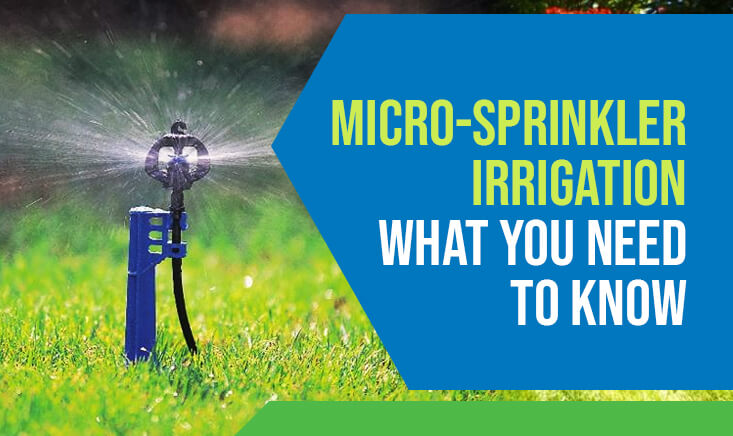Whether you’re watering your lawn or farming, it’s important to use water efficiently. That’s why micro-sprinkler irrigation has become so popular. With this system, crops get the water they need when they need it. Among different types of sprinkler irrigation systems, micro-sprinkler irrigation is the right tool for the job.
Compared to drip irrigation, micro-sprinkler irrigation is perceived as a less capable or efficient method. However, this system is a smart and efficient way to disperse high volumes of water efficiently.
Features of Micro-Sprinkler Irrigation Systems

- This low-pressure system, which uses medium to low irrigation volumes, is suitable for seasonal and high-value crops.
- It can increase yields while decreasing water, fertilizer, and labour use if managed properly.
- Micro-sprinkler irrigation is highly efficient at applying and uniformly distributing water with little to no wastage.
- It is ideal for irrigating irregularly shaped or sloping fields that can’t be furrowed or flood irrigated.
- Many irrigation companies in Toronto add fertilizer injection to the system for an additional increase in its efficiency.
Advantages and Disadvantages
Micro-sprinkler irrigation allows both localized and full-surface irrigation. Compared to drip irrigation, it can get a larger volume of soil wet, which makes irrigation management a lot easier. Also, there are more visible emitter blockages in this irrigation system.
But chances of evaporation loss and runoff from the soil surface and during water application are higher. Plus, you can’t work in the field during active irrigation and it costs more to maintain.
Because its emitter can be damaged easily, it’s important to inspect the micro-sprinklers from time to time, either yourself or by hiring a company.
It is important to inspect this system regularly and check your fields for moisture levels at different depths. This will tell you if the area is getting too much or too little water.
Picking the Right Sprinkler: 5 Things to Keep in Mind
When your investment and efforts depend on giving your plants what they need, micro-sprinklers are often the right tool for the job. But you must keep certain things in mind before picking a sprinkler.
1. Make sure the flow rate of the sprinkler matches the soil’s infiltration capacity. For heavier soil, it is best to stick with lower flow rates. It will also bring out the hydraulic and ergonomic benefits of longer irrigation and fewer shifts.
2. Check the manufacturer inspection and compare sizes to match the wetted perimeter to the root zone size. Use a micro-sprinkler with a two-stage swivel. When the tree is young, a small deflector keeps the water close to the tree, avoiding water and fertilizer wastage. As the tree grows, simply break off the deflector and the wetted perimeter will grow to fit your wider root zone.
3. Insects entering the nozzle can stop your micro-sprinkler from rotating properly, so look for one with a pop-up rotor that protects it from insect penetration.
4. Applying water and nutrients in a uniform way is critical for high-value crops, so using a pressure-compensated micro-sprinkler is highly recommended. These micro-sprinklers make sure all your trees are irrigated and fed equally, even on extreme slopes.
5. Using unreliable sprinklers can damage your investment with its poor performance, so always look for a micro-sprinkler with a proven track record in the field.
Designing a System for Micro-Sprinkler Irrigation
Irrigation companies in Toronto design the entire system around the water requirements of a specific crop. They take the highest water requirement value year so that the water supply is sufficient during that time of the year well.
1.Determining the Irrigation Areas
The effectiveness of the entire system depends on determining your irrigation areas and then choosing the micro-sprinkler and drippers accordingly. Each irrigation area will have its own pipe with similar drippers or sprinklers. In an end-to-end line, the drippers help reach the plants in the middle of a rectangular or square plantation area.
2. Calculating Water Flow
Before you buy the parts, know the flow and pressure of the water in the area. This will establish the number of sprinklers you can operate at the same time. The number of drippers should not exceed the maximum water flow capacity of the irrigation zone.
3. Determining the Soil and Water Quality
If the soil has high salt levels, irrigating with high pH can impair the ability of the tress to absorb key micronutrients. The high pH levels in soil and water can be neutralized by injecting acid into the irrigation water with a fertilizer injector. Determining the quality of water and soil will help you know if you need a fertilizer injector in your micro-sprinkler irrigation system.
4. Getting the Parts
After the irrigation company has determined the areas of irrigation and determined where your pipes and sprinklers will go, they will get the products or parts for you. The parts should be of good quality and have a proven track record. Ask the company what parts they are providing and read the reviews.
Micro-sprinkler irrigation systems can be very beneficial if they are set up correctly. However, it can be easily damaged so you’ll need to pay attention to it. For instance, if you had got it installed by an irrigation company in Toronto, they will also help you with its repair and maintenance.

